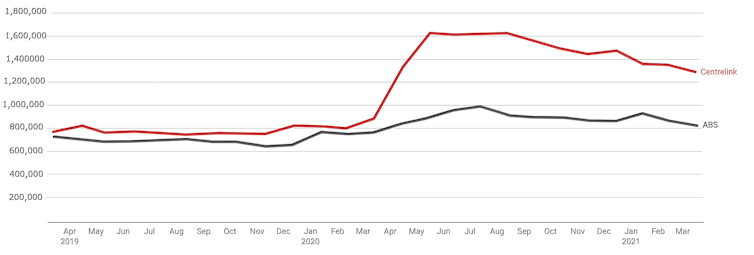Roger Wilkins, The University of Melbourne
It’s not just the end of JobKeeper that will push up unemployment in April.
The most-recently published figures, for March, had the unemployment rate coming down to 5.6 per cent
The next ones, for April, won’t get published until 20 May, nine days after next month’s budget.
They’ll show a substantial increase in the number of jobless as a result of the end of JobKeeper on 28 March. Treasury believes it will cost 100,000 to 150,000 jobs.
Another estimate, from Melbourne University’s Jeff Borland, is much higher: as much as one quarter of a million.
If all of the extra people who lost their jobs remained available for work, they would push up the total number of unemployed Australians (Australians out of work who are also looking for work) from 778,100 to more than one million.
But JobKeeper isn’t the only thing that changed at the end of March.
The conditions attached to benefits are changing
At about the same time unemployment benefits in the form of JobSeeker (for those aged 22 and over) and Youth Allowance Other (for those aged under 22) were busted back to something closer to their pre-COVID levels.
Without the coronavirus supplement, which ended on 1 April, the standard payment (excluding rent relief) fell from $715.70 to $620.80 per fortnight for single people and from $660.80 to $565.40 for partnered people.
And income tests were tightened, with the income singles can earn without losing benefits falling from $300 to $150 per fortnight, and the rate at which at which a partner’s income reduces benefits over a threshold climbing from 27 per cent to 60 per cent
Perhaps more important has been a ramping back up of the mutual obligation requirements that were wound back in April 2020.
From April this year the recommended minimum number of applications job seekers need to report each month climbed to 15. From July it will climb to 20.
Exemptions for sole traders and self-employed jobseekers ended on 1 April.
The result is likely to be an increase in the labour supply – more people looking for work.
More people looking for work
This is both because more recipients will be required to look for work and also because the mutual obligation requirements and lower payment levels will make it less attractive to remain on benefits.
More people looking for work means more people counted as unemployed.
This graph provides a sense of the potential size of the effect.
It presents the number of unemployment benefit recipients counted by Centrelink alongside the number of people identified as unemployed by the Bureau of Statistics in each month’s survey between March 2019 and March 2021.
Unemployment benefit recipients versus unemployed

Department of Social Services, ABS labour force survey
The two lines tracked each other closely up until March last year.
Then the number of unemployment benefit recipients roughly doubled to more than 1.6 million, while the number counted as unemployed climbed by much less – by only 200,000 to about one million.
The gap was largely because many recipients no longer had to look for work.
Moving back to pre-COVID settings, where looking for work will be mandatory, is likely to see the gap between these two lines narrow once again.
As many as 400,000 more jobseekers
The gap could narrow because up to 400,000 people leave unemployment benefits (lowering the red line) or because up to 400,000 people on benefits start looking for jobs and become formally unemployed (raising the grey line).
The unresolved question is the extent to which it will be the former rather than the latter.
If it is entirely the latter, it would increase the unemployment rate by nearly three percentage points.
The removal of JobKeeper and other economic headwinds mean employment growth is not likely to be strong in coming months.
This means that, for the unemployment rate not to rise significantly, more people will need to leave benefits and exit the labour force than stay on them and search for work.
This does not seem likely. It means we should not be surprised if the unemployment rate climbs back up above 7 per cent within months.![]()
Roger Wilkins, Professorial Fellow and Deputy Director (Research), HILDA Survey, Melbourne Institute of Applied Economic and Social Research, The University of Melbourne
This article is republished from The Conversation under a Creative Commons licence. Read the original article.
Do you expect a surge in Centrelink wait times in the coming months?
If you enjoy our content, don’t keep it to yourself. Share our free eNews with your friends and encourage them to sign up.

